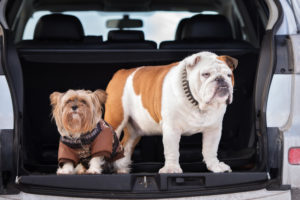
You might think holiday stress is confined to last-minute-shopping humans, over-burdened hosts or folks with in-laws they secretly refer to as “outlaws.” If the holidays are stressful for you, imagine how your aging pet feels. Your own stress plus the bustle of the holiday season compounds pet stress, and it takes elderly animals longer to bounce back. Follow these tips to help your pets have a stress-free, happy holiday.
When You’re Hosting:
If your home has become the center of activity with numerous visitors, even ones you pet already “knows,” plan ahead to keep everyone comfortable and safe.
Make a Safe Place for Retreat – Make sure your pet has their own safe, quiet area with plenty of familiar smelling blankets and a few items of your unwashed clothing to snuggle up in. It is important that they have somewhere to retreat if the festivities become too much to cope with. Supply water, favorites toys, and familiar blankets to optimize comfort, and for cats, provide litter. Be certain to create this place somewhere with a door that closes and can be off-limits to guests.
Supervise and Educate Children on Pet Handling – An overexcited child is not a good mix with an anxious dog or a worried cat, especially if your pets are older and/or are in pain. Either closely supervise or keep rambunctious kids away from the pets (or vice versa). Kids like to know all about animals, so it could be an excellent opportunity to educate them on watching for signs of stress in animals, so long as everyone involved, including your pet, can stay safe.
Signs Your Pet May Need a Break
These signs will help you – or the wee guests you’re educating — identify when your pet needs a break from the action. In context, watch for:
- Lip Licking/Yawning
- Averting Gaze or Wide Eyes
- Hackling (Raised Fur Along Spine)
- Growling
- Stiff Wagging Tail
- Shivering or Shaking
- Cowering or Tail Tucking
- Backing Away or Hiding
- Pacing and inability to settle down
Ways to Calm Your Pet
In addition to having a safe retreat, do your best to keep to your pet’s normal feeding and exercise routines.
Occupy your pet – A little extra exercise (where appropriate) and access to treats or puzzles that take time to go through can help take the pet’s mind off of its stress and relax. A long-lasting bone or chew paired with its safe space can provide relief.
Discourage visitors from handling your pet by stroking or trying to pick them up but instead encourage them to offer a few tasty treats that you have prepared as part of your pet’s daily food ration.
Don’t force your pet to be social – Respect the signals that your fur baby sends if he or she needs to retreat. Forcing a pet to be in a scary situation that causes it stress can make it worse and increases the risk of the pet injuring someone or themselves out of fear.
Try a calming aid – Calming aids such as classical music, natural calming sprays like dog appeasing pheromones (DAP) or lavender oil, and thundershirts can help take the edge off your pet’s stress. However, if your pet’s stress levels consistently escalate, consider talking to your veterinarian about anti-anxiety medication.
When You’re Travelling for the Holidays
Tips for Traveling With Elderly Pets
 Long car rides can be uncomfortable for all pets, more so for older pets. But if you need to travel to be with family and are unable to have someone stay home with your pet, there are precautions you can take to reduce the stress of the trip.
Long car rides can be uncomfortable for all pets, more so for older pets. But if you need to travel to be with family and are unable to have someone stay home with your pet, there are precautions you can take to reduce the stress of the trip.
• Check With Your Vet In Advance & Plan Ahead – Get any prescriptions you may need, as well as anti-nausea medication if your pet tends to get motion sickness or vomits when anxious. For example, if your dog has a history of anxiety during car rides, your vet may prescribe Cerenia (FDA approved for dogs) for nausea and Trazadone or a similar medication for anxiety.
For pets who are on pain medication, plan suitable dosages for traveling and consider that you may want to reduce food intake during the trip, depending on duration. Some medications need to be taken with food, so keep this in mind when planning your trip. Take copies of your pet’s paperwork with you, and be sure you’ve looked up emergency vet services at your intended destination in case you need assistance.
• Take a Pet First Aid Kit – When traveling, pack a simple travel-size first aid kit for your pet, similar to the one you have at home, along with an antidiarrheal medication that is safe for animals, depending on your vet’s recommendations. Ensure you have an adequate supply of any medications your pet is currently taking.
• Familiarity Helps Reduce Stress – Be sure that your pet’s crate, or seat area if you use a restraint system, have familiar blankets and favorite toys that smell like home. Also be prepared with your dog or cat’s usual food. Older pets are more prone to gastrointestinal upset than younger fur babies. A change in diet may upset you both!
• Protect Their Joints – Orthopedic mattresses are invaluable to elderly pets on long car rides. They will help protect your pet’s joints from jostling and increase their comfort level.
• Stay Calm — If you’re traveling a long distance with an older dog or cat, pay attention to how your anger at other motorists or frustration at delays affects your fur baby. Every stressor you can eliminate will make the trip easier on your dog or cat – and yourself!
